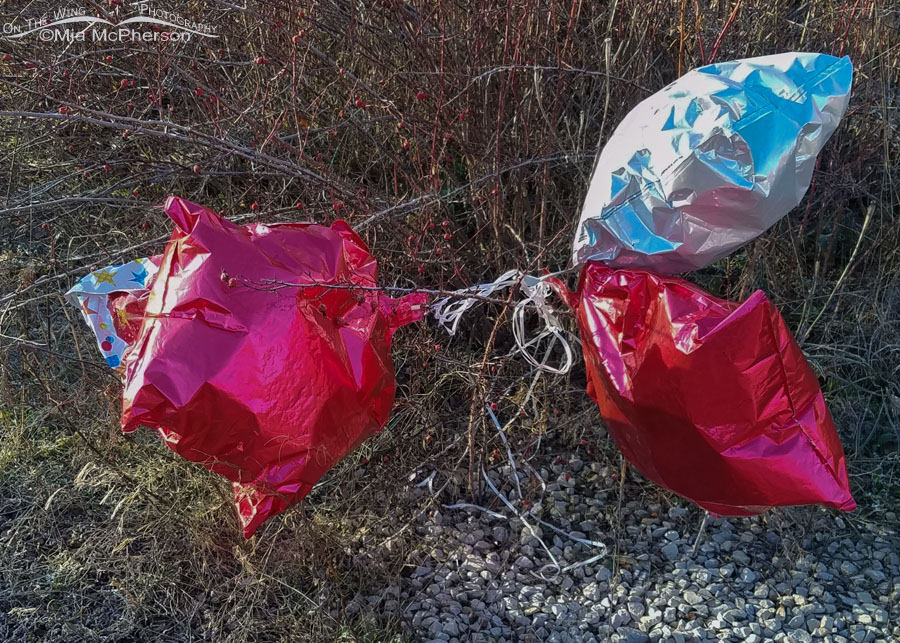Last Sunday I went to some local spots to look for birds. As I was driving, I saw four mylar balloons stuck in some shrubs near the Jordan River. My heart sank.
 Four balloons tangled in shrubs – Samsung cell phone photo
Four balloons tangled in shrubs – Samsung cell phone photo
I drove across a bridge to get to the other side of the river, parked, and made my way down the riverbank to retrieve the balloons.
Balloons don’t belong in nature; they are a hazard for birds and wildlife.
Once I was able to pull the strings attached to the balloons out of the shrubs, I took them and tucked them safely into my Jeep for proper disposal at home.
I have seen these mylar balloons even when I have been way out in the wilderness, scores of miles away from the closest humans, stuck in trees, grasses, and shrubs. Floating on water and heading down stream.
Sometimes I can’t get to the balloons to dispose of them safely.
When that happens? It breaks my heart.
Balloons can harm birds and wildlife in several ways.
Birds, turtles, and other animals often mistake balloons for food, which can lead to injury or death. When animals ingest balloons, it can block their digestive tracts, leading to starvation and death.
Additionally, balloon strings can entangle animals, causing harm or even death. Balloons also contribute to environmental litter, posing a threat to various wildlife, including marine animals.
The evidence from various sources clearly indicates that the release of balloons poses a significant threat to wildlife. The ingestion and entanglement of balloons have been linked to the injury and death of birds, turtles, and other animals.
These mylar balloons, which are made of a polyester film and/or metal layer, do not break down easily or naturally. They are not biodegradable and can take hundreds of years to degrade. When they do degrade, they become microplastics, posing a significant threat to marine life and the environment.
Even biodegradable balloons can be a danger to the environment and wildlife. While manufacturers claim that latex balloons are biodegradable and can degrade in the same amount of time as an oak leaf, the reality is different. Biodegradable balloons are made with latex and various other chemicals, which can take anywhere between six months and six years to start degrading.
That translates to six months OR years in which time any birds and animals that find them are at risk of suffocation, starvation, and death.
Balloons are not safe for wildlife or our environment.
Today is Valentine’s Day, please show your love without balloons and save lives.
Life is good, WE can make it safer and better for wildlife.
Mia
See more of my miscellaneous images in a gallery here.


I gather up balloons all the time, here in Utah County; at the lake in the hills…it is a problem. Thank you so much for your blog post. Education is the best deterrent.
Glad you were there. Just ain’t no figuring out why people are so thoughtless and downright stupid. Thanks Mia.
I commend your post, but you’re probably preaching to the choir. The use and misuse of balloons and string would make a good segment on one of the local news programs.
Thank you, Mia for the information, and picking up the balloons.
I’m so glad you were able to get them out of the bush for proper disposal before an animal was injured or killed. I don’t but balloons any more for that reason.
Thank you for picking them up, Mia. Here’s to a (balloon-free) Happy Valleytines for everyone! 💜
We are off the beaten path and find balloons in the woods. Our idiot funeral home does a balloon release. Complained but got me nowhere.
Will we ever learn…
Amen!!
Hear, hear!!!